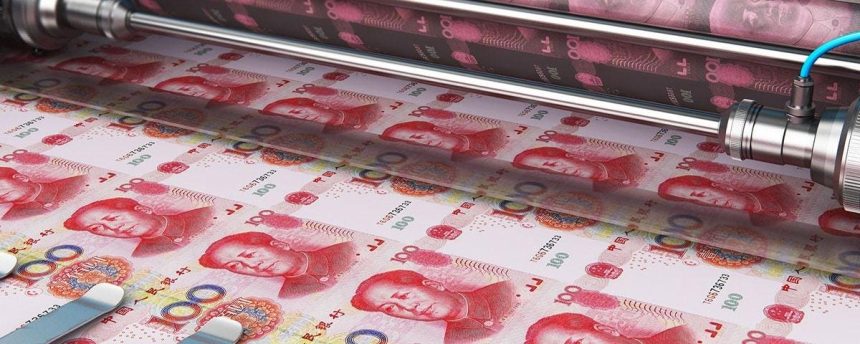Key News
Asian equities had another sharp fall as Japan underperformed the region by 3%, while Taiwan was closed again due to a typhoon.
The risk-off environment sent safe haven currencies such as the yen higher by +0.94% versus the US dollar, leading to other Asian currencies higher, including China’s Renminbi (CNY), which gained +0.62% versus the US dollar from yesterday’s 7.26 to 7.22 today (CNY is quoted as the price of $1 in CNY, so a decrease represents appreciation). Yesterday, I speculated that a US dollar decline could exacerbate the US technology sell-off as foreign investors’ losses could be exacerbated by the US dollar decline, which is just an observation.
Hong Kong was not immune to the risk-off and beta sell-off, while the National Team’s buying limited Mainland China’s drawdown.
Another surprise in morning trading was that the PBOC unexpectedly cut the medium-term lending facility (MLF), the interest rate for banks to borrow from the PBOC, from 2.5% to 2.3%. This follows the unexpected reduction in the 1 and 5-year loan prime rate from 3.45% to 3.35% and from 3.95% to 3.85%. The 7-day reverse repo rate was also cut earlier this week, from 1.8% to 1.7%. Mainland banks have started to cut their deposit while the 5-year loan prime rate determines mortgage rates. Positive news that has been met with the usual Western media skepticism/negativity. True, China’s economy doesn’t suffer from a supply issue but a demand issue.
The flurry of activity is before next week’s Politburo meeting that will provide further economic policy and hopefully stimulus post-the Third Plenum. Remember, the Third Plenum does not create policy but looks at the economy broadly, which includes acknowledging that things are not all rainbows and unicorns.
Today, the National Development and Reform Commission (NDRC) and Ministry of Finance announced “Several Measures to support Large-scale Equipment Update and Consumer Goods Trade-in-Package”. The policy package will allow for the issuance of up to CNY 300 billion worth of ultra-long-term government bonds, allowing for upgrades and trade-ins supporting the purchase of energy saving equipment in various industries. The money will be directed to “bulk consumer goods such as automobiles and home appliances” to promote “the replacement of old consumer goods with new ones.” This explains why Haier Smart Home (6690 HK) was up +5.13% and Hisense Home Appliance (921 HK) was up+7.49%, despite today’s drawdown in Hong Kong.
Mainland-listed electric vehicles (EVs), EV ecosystem plays, and home appliance makers were all up overnight, though similar names were whacked overnight in Hong Kong. Foreign investors freaked out in Hong Kong on the global risk-off, as all sectors and subsectors were negative, only 74 stocks up versus 406 decliners, as Mainland investors sold $597 million worth of Hong Kong-listed ETFs via Southbound Stock Connect. The Mainland market, which is held more by domestic investors than Hong Kong, was mixed, with only three negative sectors and two stocks up for every down stock as local investors better understand the PBOC and NDRC moves. Without the energy sector and stocks, the Mainland market likely would have increased as commodity prices fall. Copper and steel were down -7.41% and -9.04%, respectively, in the last month. The National Team was active in their favorite ETFs as the market fell in the after volumes spiked every time. I will put a chart up on Twitter as (@ahern_brendan) as it is a crazy chart. Investors seemed poorly positioned if we get a fiscal stimulus next week.
Some Asia-based strategists think that a potential Trump win will be negative for China, based on claims of 60% tariffs. I don’t believe it because 60% tariffs would crater the US stock market and economy, unleashing crushing inflation. If you believe these are happening, short Wal-Mart, Home Depot, Costco, and Amazon! We see this as the “Art of the Deal” in action. I recommend watching our interview with Terry Branstad, Trump’s Ambassador to China.
All this talk also begs the question: how did Chinese stock fare under Trump’s first term? Please see the below. Returns are in US dollar terms.
- MSCI China +111%
- MSCI EM +92%
- China Internet Index +124%
- Shanghai Composite +17%
- Shenzhen Composite +15%
- S&P 500 +106%
- All Country World ex US +61%
Yes, there were bumps in the road, and the mainland underperformed, but not badly, right?
The Hang Seng and Hang Seng Tech fell -1.77% and -2.00% on volume that increased +21.67% from yesterday, which is 103% of the 1-year average. 74 stocks advanced, while 406 declined. Main Board short turnover, which increased +5.71% from yesterday, which is 98% of the 1-year average, as 16% of turnover was short turnover (Hong Kong short turnover includes ETF short volume, which is driven by market makers’ ETF hedging). Value and small caps “outperformed” and fell less than large caps and growth stocks. All sectors were negative, with materials -4.51%, communication -2.8%, and energy -2.65%. All sub-sectors were negative, with materials, semis, and media the worst performers. Southbound Stock Connect volumes were moderate as Mainland investors sold -$597mm of Hong Kong stocks and ETFs, with Tencent a small net buy while the Hong Kong Tracker ETF was a large net sell, HS Tech ETF and HS China Enterprise ETF were net moderate net sells.
Shanghai, Shenzhen, and the STAR Board were mixed -0.52%, James Bond +0.07%, and STAR Board +0.08% on volume -6.09% from yesterday, which is 72% of the 1-year average. 3,43,3 stocks advanced while 1,422 declined (SH and SZ had 711 stocks fall; what’s the probability?). The top sectors were real estate +1.76%, communication +1.35%, and discretionary +0.98%, while energy -1%, materials -0.61%, and tech -0.09%. The top sub-sectors were building materials, water, and power generation equipment, while precious metals, oil/gas, and electronic components were the worst. Northbound Stock Connect volumes were moderate as foreign investors were net sellers of Mainland stocks, with Zijin Mining a moderate net buy, Eoptlink and DSBJ small net buys, while Kweichow Moutai was a moderate/large net sell, CATL, and ICBC small net sells. Treasury bonds rallied. CNY and the Asia dollar index had a strong day compared to the US dollar. Copper and steel were down.
Upcoming Webinar
Join us on Thursday, August 8th at 1 pm EDT for:
Overview of Hedgeye’s Proprietary Risk Range™ Signals & A New ETF To Help Manage Risk In US Equities
Please click here to register
New Content
Read our latest article:
Revisiting Hong Kong: Optimism Still Improving Even As Rally Gets Tested
Please click here to read
Last Night’s Performance
Last Night’s Exchange Rates, Prices, & Yields
- CNY per USD 7.21 versus 7.27 yesterday
- CNY per EUR 7.83 versus 7.88 yesterday
- Yield on 10-Year Government Bond 2.21% versus 2.23% yesterday
- Yield on 10-Year China Development Bank Bond 2.26% versus 2.29% yesterday
- Copper Price -1.50%
- Steel Price -1.44%
Read the full article here
















